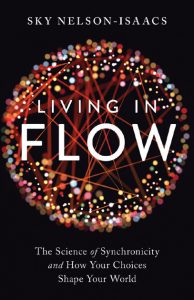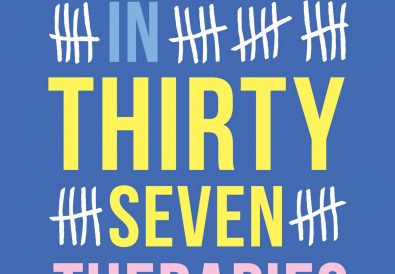I believe we are creatures of flow. Flow is natural to each of us in our own way. At a party we may feel engrossed in a conversation and want the rest of the party to disappear, or we may naturally feel the ending of the conversation when one person goes to refill their drink.
At work we may feel totally engaged with a task for a period of time and then naturally sense when it has fulfilled its course for the day and we move on to something else.
However, the flow doesn’t mean that we go with the whims of our fancy. Being in flow is not always “going with the flow.” Flow is not a passive practice. Shaping our world often involves lighting a spark. A beneficial set of circumstances may be obtainable, but it may depend upon taking a risk of some kind or pushing back on the status quo. Flow teaches us how to listen to and align with the circumstances, but sometimes we have to go against one set of circumstances to align with another. Through developing and trusting our inner senses or intuition, we can become better at discerning which is which.
Sometimes flow involves letting go of attachment to a certain path; sometimes it involves pushing through resistance to stay on a certain path. Flow is a middle path between rigidity and spontaneity. In flow, we keep our highest goals in mind, and then our instinct helps us interpret the circumstances in the most productive way. How do we know when to push and when to surrender? Flow teaches us to simultaneously fight for what we love and also “trust the river” of life events. I find it helpful to maintain a clear bottom line: what is important to me?
Sometimes being in the flow requires sacrifice, hard work, and loss of sleep; sometimes it requires ease, relaxation, and surrender. Sometimes building what we love requires pushing a boulder up a hill, and sometimes it involves letting it roll down the hill and adapting to where it stops. Just as with an intense tennis match, extraordinary effort can be part of the flow. How do we know? We can tell because of how we feel when we are doing it. If we are clear about our purpose in what we are doing, we naturally enter into flow in any activity.
This may seem challenging to incorporate into a highly structured situation where the errors have big consequences, such as using flow to meet one’s quarterly financial goals and keep one’s job. In Frederik Laloux’s book Reinventing Organizations, he shows us how a number of self-managed organizations incorporate this sort of attitude into their workflow. Organizations that are built on hierarchical decision making often don’t have much room for flow. When your manager walks up to you and says, “I need this done right now,” there’s no room for listening, opening, or reflecting; you just have to act in the way you’re told.
But the organizations Laloux studied operate in a different way: they are selfmanaged. The organization feels more like a single organism than a bunch of individuals. Various processes are put in place to ensure that the power for decision-making is distributed across the organization and that each individual has incentive to take responsibility for highquality outcomes.
For instance, any member of such an organization can make any decision, but they must use what is called the “advice process.”
In this process the decision maker must get input or advice from all stakeholders who will be affected by the decision and then consider that advice seriously. They are then empowered to make whatever decision they deem appropriate based on the information they have gathered. The pressure to make good decisions comes from the sense of accountability each member has to their team. When each member is trusted and respected, a sense of coherence within the team grows, which supports accountability.
This approach nurtures flow because each individual is empowered to follow what they deem to be the best course of action in the moment; they are encouraged to trust themselves. Laloux found that for this mind-set to work, it is important for this approach to be fully implemented rather than just paying surface-level lip service to the notion of mutual trust. When people truly know they are trusted, they will feel a sense of ownership and will bring everything they have to their efforts. A synergy and dynamism can emerge that results from a greater sense of flow.
One of the organizations Laloux studied was a power generation company. Obviously a utility company needs strict standards of control in order to ensure safety and reliability, but they are able to do so within a model of self-management. One of the team members was originally from Pakistan and had the idea that the company should build a facility in his native country. The CEO felt it was a risky venture and was skeptical, but the advice process meant the decision was the employee’s. After following through on the advice process, the team member decided to go for it. He had at his disposal all the resources necessary to implement such a vision, and he was able to enroll enough of his fellow teammates in the project to get it off the ground.
The ability (or inability) to enroll others in an idea is a natural check and balance that exists within flow. The idea of lighting a spark is to see hidden potentials and ignite them. If there is no kindling around—if none of a person’s teammates can see the same value in the idea—that might indicate that the action is not in the flow. In today’s dominant system of hierarchies, in which one person’s voice has the power to silence the rest, this natural system of checks and balances doesn’t have a chance to emerge. Without flow, we rely on obedience to get things done. When we expect obedience of people, we don’t win their enthusiasm, and their most valuable asset is withheld from the project.
Flow is not a structure-less, laissez-faire attitude in which anything goes. It is a dynamic balance between will and surrender, a democratization of information that can be facilitated via specific organizational structures.
From Living in Flow by Sky Nelson-Isaacs. Published by North Atlantic Books, copyright © 2019 by Sky Nelson-Isaacs . Reprinted by permission of publisher.

 Sky Nelson-Isaacs is a physics educator, speaker, author, and musician. He has a masters degree in physics from San Francisco State University, with a thesis in String Theory, and a BS in physics from UC Berkeley. Nelson- Isaacs has dedicated his life to finding his own sense of purpose, beginning as a student of the Yogic master Sri Swami Satchidananda when he was less than five years old. His writing on topics like flow comes from integrating this experience into his life. He brings together the connection between synchronicity, physics, and real life using research and original ideas. An educator with nine years of classroom experience, with experience in industry as a software engineer, Nelson-Isaacs is also a multi-instrumentalist and professional performer of award-winning original musical compositions.
Sky Nelson-Isaacs is a physics educator, speaker, author, and musician. He has a masters degree in physics from San Francisco State University, with a thesis in String Theory, and a BS in physics from UC Berkeley. Nelson- Isaacs has dedicated his life to finding his own sense of purpose, beginning as a student of the Yogic master Sri Swami Satchidananda when he was less than five years old. His writing on topics like flow comes from integrating this experience into his life. He brings together the connection between synchronicity, physics, and real life using research and original ideas. An educator with nine years of classroom experience, with experience in industry as a software engineer, Nelson-Isaacs is also a multi-instrumentalist and professional performer of award-winning original musical compositions.




















